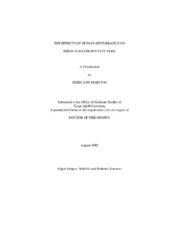| dc.description.abstract | With rapidly disappearing natural areas due to development and fragmentation,
public lands provide important habitat for birds. However, the increasing use of public
lands for recreation may decrease the value of these areas for bird use. Human
disturbance can damage birds in many ways, including disrupting foraging or social
behavior, increasing nest predation, interfering with parent-offspring and pair bonds,
increasing nesting failures, and reducing the viability of fledglings. Additionally, birds
may perceive humans as predators and leave an area, and the resulting decline in species
abundance resembles the effects of habitat loss. Increased human outdoor activity has
created the need for information regarding the effects of human disturbance on birds. I
investigated the effects of human disturbance on birds in Bastrop State Park (BSP) in
central Texas in 1998 and 1999. A wide variety of people use much of BSP, and many
areas within the park experience significant amounts of disturbance from people and
vehicles, particularly in campgrounds. I evaluated the effects of various types of human
disturbance on the presence of 20 avian species, including seven neotropical migratory
species. Brown-headed Cowbird (Molothrus ater), Mourning Dove (Zenaida macroura), Carolina Wren (Thryothorus ludovicianus), and Summer Tanager (Piranga
rubra), were sensitive to human presence, and Blue Jays (Cyanocitta cristata), and
Downy Woodpeckers (Picoides pubescens) occurred in lower abundances in sites with
higher numbers of vehicles. However, other species (e.g., American Crow [Corvus
brachyrhynchos], Black-and-white Warbler [Mniotilta varia], Pileated Woodpecker
[Dryocopus pileatus], Red-eyed Vireo [Vireo olivaceus], Ruby-throated Hummingbird
[Archilochus colubris], White-eyed Vireo [Vireo griseus], and Yellow-billed Cuckoo
[Coccyzus americanus]) tolerated humans, vehicles, or both. Neotropical migratory
species did not show higher sensitivity to disturbance when compared to resident
species, and forest interior species were not more sensitive than edge species. My
results indicate that some species, including migrants, can become habituated to human
presence in protected areas with low harassment and low-intensity, predictable
disturbances. Management recommendations for BSP include protecting habitat,
minimizing human disturbance in some areas, providing buffer zones between humandominated
zones and sites containing vulnerable species, and softening edges in
campgrounds. | en |


